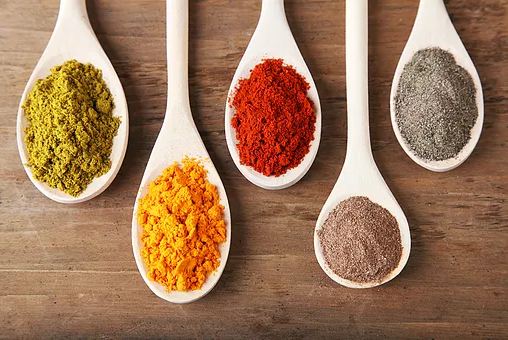Warming Herbs for Cold Winter Days
As the chill of winter sets in, we are forced to adapt to the changing season. For most of us, this means bundling up and trying to stay warm. However, through the lens of Asian medicine, there is a lot more to staying warm then just putting on a scarf and toque.
In Asian medicine, health and the human body are viewed in terms of the physical state, as well as energetic flow and inter-organ relationships. For
example, Qi (energetic life force) is thought to flow through the body from organ to organ along specific pathways, called meridians. This energetic flow happens on a daily basis, with different organ systems being emphasized at different times of the year. Each organ has a physical function (similar to a conventional Western medical view), as well as a broad range of other supportive roles. From this perspective, health and vitality prosper when each organ is in harmony and Qi is flowing smoothly.
Several factors can impact the flow of Qi and the state of an organ; season and temperature being two important ones (warm vs cold, dry vs damp, etc).

By: Dr. Martha Sharpe ND
Clinic Resident

That said, colds and flus acquired in winter months are generally thought to be due to “Cold Invasion” into the body, when our external defense systems are compromised due to cold weather, exposure to bugs, and reduced physical activity and sunlight exposure.
n order to promote optimal health and vitality, especially during changing seasons, it is important to choose foods that support organ function and take into consideration the stressors the body might be under. For example, digestion of food requires a great deal of energy, with bodily “fire” (you can think of this as internal heat or energy) directed internally to warm, break down, and assimilate food and nutrients. In the winter, this process can be straining on the body when cold, damp foods are eaten, as more warmth is directed internally. This, in turn, reduces the ability of the body to fortify its external defenses and compromises immunity by allowing coldness to settle in.
Cold winter days require foods with a “warming” property. This means warm in temperature, warm in nature, and/or easy to break down, thus stimulating digestive “fire” and ensuring ease of digestion. Be mindful of the following simple Asian medicine tips to eat for warmth during the cold season (1):
- Cook your food, and eat it warm – raw foods are inherently “cold” in nature, and therefore are often more taxing on digestive function. Food eaten cold, even when cooked, is “cold” in nature as well.
- Choose firey-coloured foods (red, orange, yellow) – it is not a coincidence that these colours are actually more “warming” in nature than cooler-coloured foods (green, blue, purple), and support digestive “fire”.
- Cook food for longer – steaming and simmering is more “warming” than quick frying, and foods cooked in this way are easier to digest as many structural components (fibers, proteins) have already begun to break down.
- Chew food for longer – we often forget that digestion of food begins in the mouth with mechanical chewing and activation of salivary digestive enzymes. This step is neglected when we eat quickly or on the go, but can provide food with more energy and “warmth” before it hits the stomach.
The following is a favourite winter elixir recipe with the ingredients listed above to warm you from the inside on the coldest winter day:
- ½ tsp whole clove
- ½ tsp whole cardamom seed
- 1/8 tsp ground cinnamon
- 1 tsp turmeric
- 1 tsp ghee
- 1 ½ cups almond milk
Blend together, strain, heat over the stove, and enjoy!
To learn more about Asian medicine as a holistic view of health and how it can benefit you, book an appointment with any one of our friendly, knowledgeable Naturopathic Doctors at the Marsden Centre for Excellence in Integrative Medicine.
References:
- Pitchford P. Healing with whole foods: Asian Traditions and Modern Nutrition. 3rd Ed. 2002. North Atlantic Books: Berkley CA.
- Cortés-Rojas DF, de Souza CR, Oliveira WP. Clove (Syzygium aromaticum): a precious spice. Asian Pac J Trop Biomed. 2014 Feb;4(2):90-6. doi: 10.1016/S2221-1691(14)60215-X.
- Hoffmann D. Medical Herbalism: The Science and Practice of Herbal Medicine. 2003. Healing Arts Press: Rochester VT.
- Hamidpour R, Hamidpour M, Hamidpour S, Shahlari M. Cinnamon from the selection of traditional applications to its novel effects on the inhibition of angiogenesis in cancer cells and prevention of Alzheimer’s disease, and a series of functions such as antioxidant, anticholesterol, antidiabetes, antibacterial, antifungal, nematicidal, acaracidal, and repellent activities. J Tradit Complement Med. 2015 Jan 16;5(2):66-70. doi: 10.1016/j.jtcme.2014.11.008. eCollection 2015.
- al-Zuhair H, el-Sayeh B, Ameen HA, al-Shoora H. Pharmacological studies of cardamom oil in animals. Pharmacol Res. 1996 Jul-Aug;34(1-2):79-82. PMID: 8981560
- Ahmad B, Rehman MU, Amin I, Arif A, Rasool S, Bhat SA, Afzal I, Hussain I, Bilal S, Mir Mu. A Review on Pharmacological Properties of Zingerone (4-(4-Hydroxy-3-methoxyphenyl)-2-butanone). Scientific World Journal. 2015;2015:816364. doi: 10.1155/2015/816364. Epub 2015 May 27.
- Kawada T, Sakabe S, Watanabe T, Yamamoto M, Iwai K. Some pungent principles of spices cause the adrenal medulla to secrete catecholamine in anesthetized rats.
Proc Soc Exp Biol Med. 1988 Jun;188(2):229-33. PMID: 3375268. - Mahmood K, Zia KM, Salman M, Anjum MN. Recent developments in curcumin and curcumin based polymeric materials for biomedical applications: a review. Int J Biol Macrmol. 2015 Sep 21; 81;877-890. Doi10.1016/j.ijbiomac.2015.09.026. [Epub ahead of print].